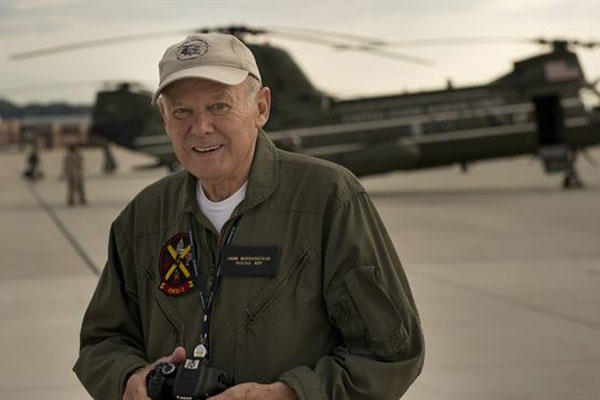Marine Corps Air Facility Quantico, Va. -- A trailer sits near the lone hanger of Marine Helicopter Squadron One on Marine Corps Air Facility Quantico, Virginia.
Inside the thin walls are decorated with framed photos of CH-46 Sea Knight helicopters and notable public figures. Models of the aircraft are displayed across a shelf above a computer. Scrapbooks with personal memorabilia fill the bookshelves—this is the office of John Morgenstern.
“My job has been my passion there’s no doubt about that,” said Morgenstern. “Every morning, I look forward to coming to work.”
For the last 47 years, Morgenstern has worked with HMX-1 as their CH-46 technical expert.
After earning a bachelors degree in aircraft maintenance, Morgenstern interviewed with Boeing.
“I showed up for my interview,” said Morgenstern. “The interviewer said, ‘What would you like to do?’ I said, ‘I’d like to be one of your tech reps.’ My interview lasted three minutes.“
“Of course, there’s no email in those days. Two weeks later, I get this Western Union telegram, which says, ‘We’d be delighted to have you on our field service staff.’”
Morgenstern began his new job earning $7,000 annually and spent months going to all the factory schools to improve his knowledge of the Sea Knight. Afterward, he then arrived at the squadron in 1967 and never left.
“I’ve had tech reps at every squadron I’ve been to,” said Staff Sgt. Geoffrey Green, a CH-46 helicopter crew chief with HMX-1. “I’ve never met someone as passionate, as smart or as engaged as John Morgenstern.”
He was selected to be the technical expert for the squadron during the conflict in Vietnam during 1968, after the previous technician was injured by shrapnel. Morgenstern’s job was to assess the damage of each CH-46 after rocket attacks. Every hole through the aircraft had to be counted.
“Maybe you counted 53 holes on the right side and 46 holes on the left side,” said Morgenstern. “Then you wondered where all the other shrapnel went. Is it in the sync shift, transmission, oil cooler. You learn a lot about the aircraft.”
After his return from Vietnam he continued his work during a time of relative peace. Morgenstern suggested to the commanding officer of the squadron the aircraft be painted to give them a shiny finish. He painted some water colored pictures of shiny aircraft to showcase his ideas.
“The next thing you knew we had some shiny 46s,” said Morgenstern.
Morgenstern continuously pushed the limits of the CH-46 to prove its capabilities.
“One time I argued with a Marine that it could carry a tow tractor which was thought to have been much too big,” Morgenstern said. “I measured and found there was an inch and a half extra space to fit it in, all the Marine needed was a good driver.”
The photo of the event can still be seen in Morgenstern’s office.
“It’s kind of intimidating to go and talk to someone who’s been doing this for 50 years, but he welcomes everyone," said Green. It’s been a great experience working with him. He takes his job very seriously, he’s very passionate about it.”
With his sparkling blue eyes and thinning white hair, the young Marines he works with could catch themselves calling him Grandpa rather than John or Mr. Morgenstern.
“It’s important to me that I know every lance corporal, corporal and sergeant,” said Morgenstern. “Those are the kids that make it happen.
“They don’t necessarily get the credit but they make it happen, no matter the weather or the job. If you really want the job done go to a Marine base and they’ll make it happen.”
The last CH-46 helicopters departed HMX-1 in July to be turned over to the state department. Morgenstern was on the last one.
During the last decade the newer and more modern MV-22B Osprey has all but completely replaced the venerable CH-46.
The Osprey is a dual-tilt rotor aircraft, which can take off, hover and land like a helicopter, but achieve high speed by flying like a fixed winged aircraft.
“This is my paradise,” said Morgenstern looking around his office admiring all the CH-46 memorabilia and personal mementos.
“The 46 has been my whole life,” said Morgenstern. “You think about somebody spending 50 years with the same product. The only thing I know is the 46.”
The trinkets Morgenstern surrounds his workspace with showcase not only the accomplishments of the Phrog, but the men and women, who made them jump into the sky.
“Someday when I retire from here, I’ll take all of this with me,” said Morgenstern gazing around his office. “I’ll rent an office somewhere, sit down and maybe write a book. My friends say, ‘if you do John make sure half of it is pictures.’
“I don’t want to give it up.”



























